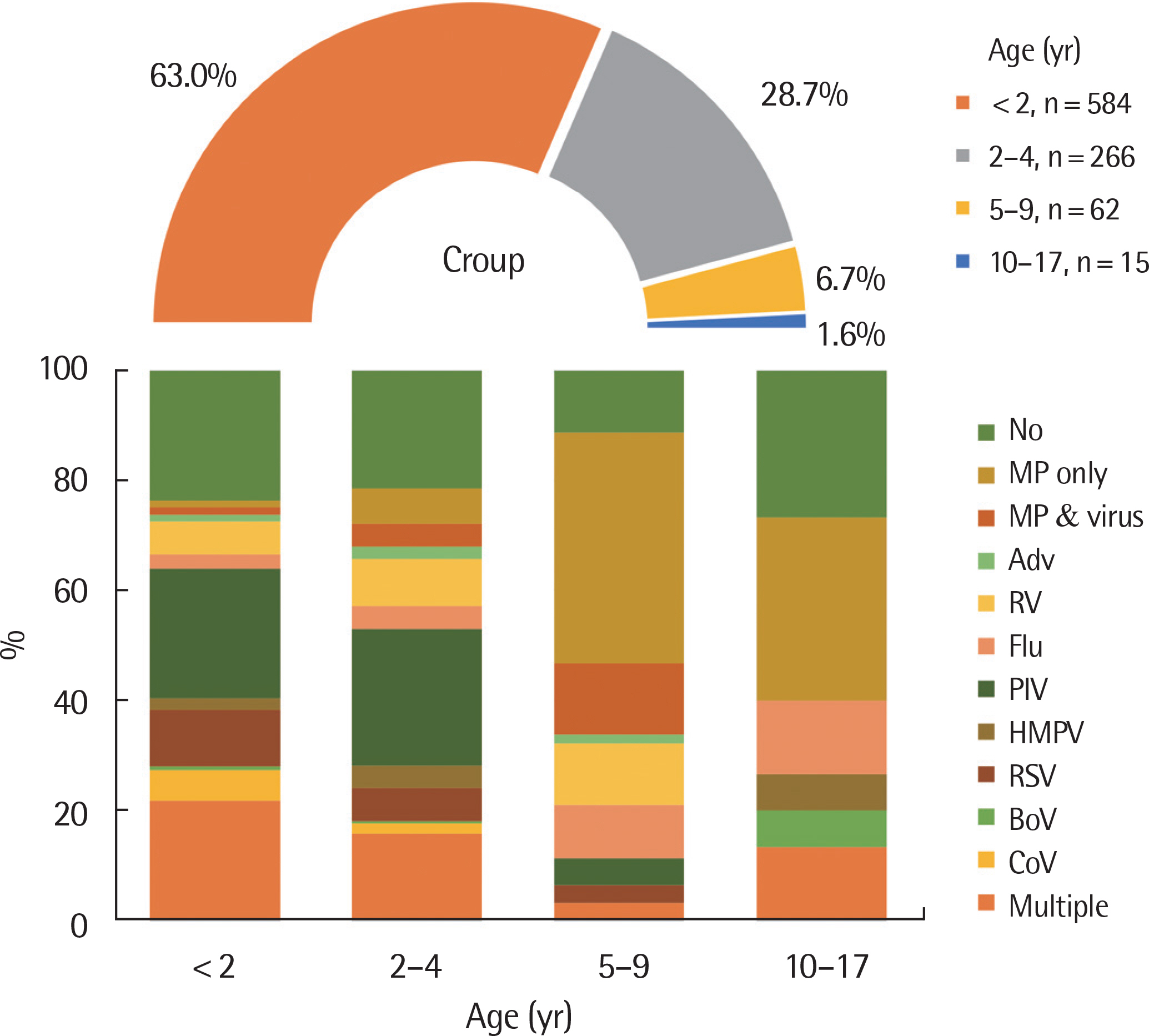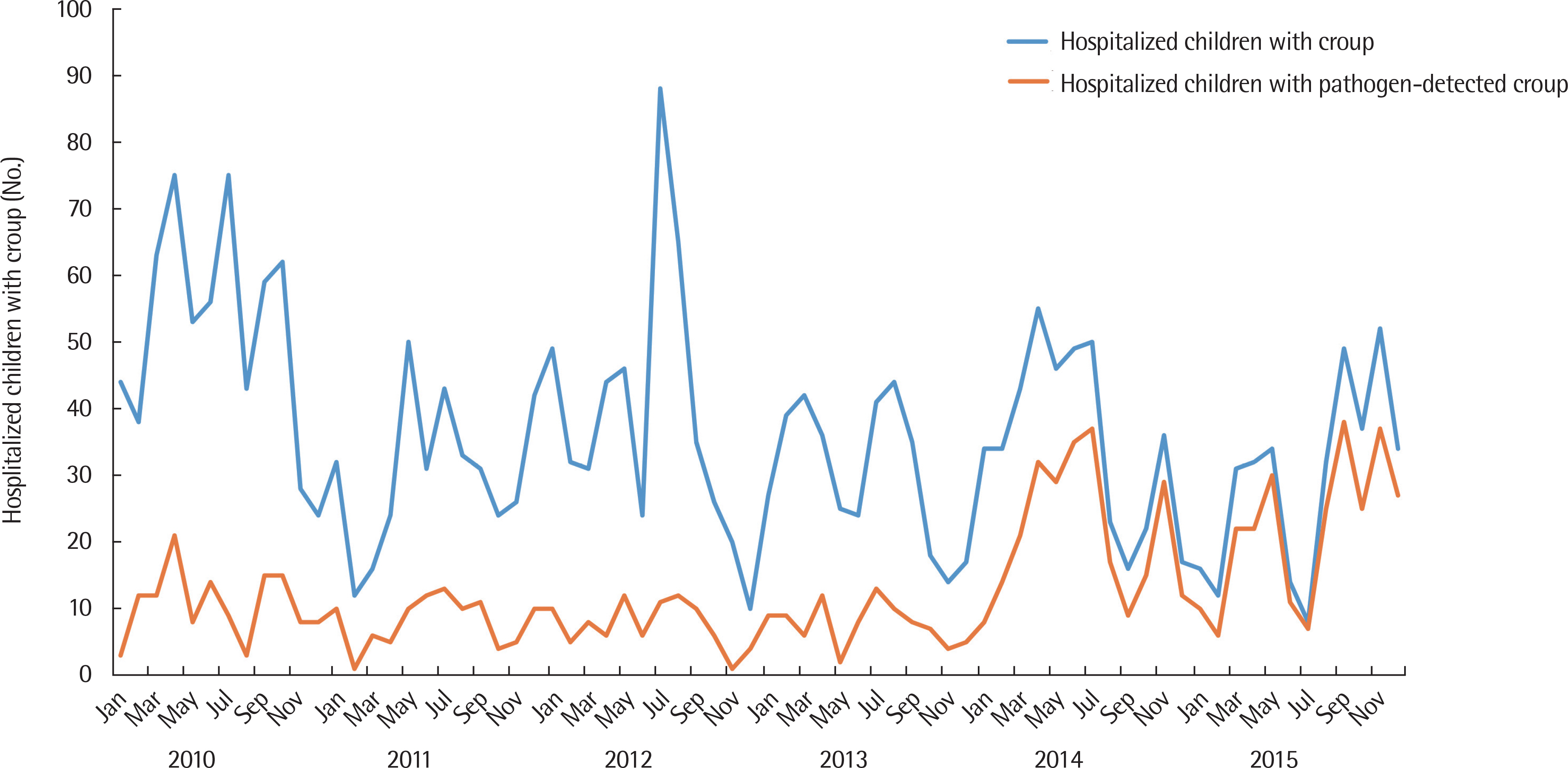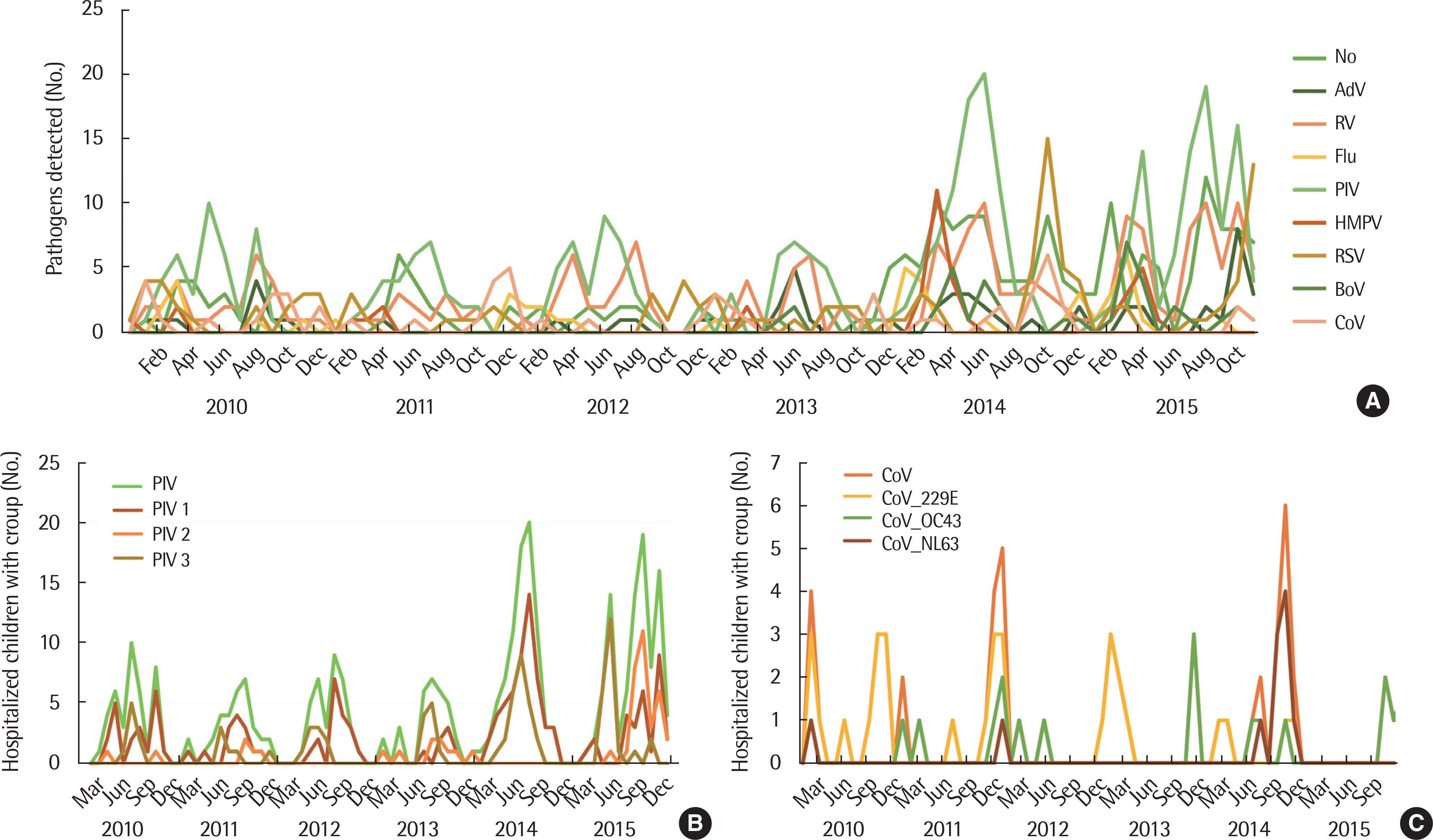Allergy Asthma Respir Dis.
2019 Apr;7(2):78-85. 10.4168/aard.2019.7.2.78.
Seasonal patterns and etiologies of croup in children during the period 2010–2015: A multicenter retrospective study
- Affiliations
-
- 1Department of Pediatrics, Hallym University Kangnam Sacred Heart Hospital, Seoul, Korea.
- 2Department of Pediatrics, Asthma and Allergy Center, Inje University Sanggye Paik Hospital, Seoul, Korea.
- 3Department of Pediatrics, Gangneung Asan Hospital, University of Ulsan College of Medicine, Gangneung, Korea.
- 4Department of Pediatrics, Samsung Changwon Hospital, Sungkyunkwan University School of Medicine, Changwon, Korea.
- 5Department of Pediatrics, Pusan National University Yangsan Hospital, Yangsan, Korea.
- 6SCH Biomedical Informatics Research Unit, Soonchunhyang University Seoul Hospital, Seoul, Korea. pedyang@schmc.ac.kr
- 7Department of Pediatrics, Dankook University Hospital, Cheonan, Korea.
- 8Department of Pediatrics, Yonsei University Severance Hospital, Seoul, Korea.
- 9Department of Pediatrics, Soonchunhyang University Gumi Hospital, Gumi, Korea.
- 10Department of Pediatrics, Inje University Haeundae Paik Hospital, Busan, Korea.
- 11Department of Pediatrics, Korea University Guro Hospital, Seoul, Korea.
- 12Department of Pediatrics, Eulji University Eulji General Hospital, Seoul, Korea.
- 13Department of Pediatrics, Korea Cancer Center Hospital, Seoul, Korea.
- 14Department of Pediatrics, Asan Medical Center, University of Ulsan College of Medicine, Seoul, Korea.
- 15Department of Pediatrics, Hanyang University Guri Hospital, Guri, Korea.
- 16Department of Pediatrics, Chonnam National University Hospital, Gwangju, Korea.
- 17Department of Pediatrics, National Health Insurance Service, Ilsan Hospital, Ilsan, Korea.
- 18Department of Pediatrics, Daegu Catholic University Medical Center, Daegu, Korea.
- 19Department of Pediatrics, Chungnam National University Hospital, Daejeon, Korea.
- 20Department of Pediatrics, Dongguk University Gyungju Hospital, Gyungju, Korea.
- 21Department of Pediatrics, Sowha Children's Hospital, Seoul, Korea.
- 22Department of Pediatrics, Seoul National University Children Hospital, Seoul, Korea.
- 23Department of Pediatrics, CHA University CHA Bundang Medical Center, Seongnam, Korea.
- 24Department of Pediatrics, Soonchunhyang University Seoul Hospital, Seoul, Korea.
- 25Division of Pediatric Allergy & Pulmonology, Department of Pediatrics, Sungkyunkwan University School of Medicine, Kangbuk Samsung Hospital, Seoul, Korea. jy7.shim@samsung.com
- 26Department of Pediatric Allergy & Pneumology, Catholic University Uijeongbu St. Mary's Hospital, Uijeongbu, Korea.
- KMID: 2444840
- DOI: http://doi.org/10.4168/aard.2019.7.2.78
Abstract
- PURPOSE
Croup is known to have epidemics in seasonal and biennial trends, and to be strongly associated with epidemics of parainfluenza virus. However, seasonal and annual epidemics of croup have not been clearly reported in Korea. This study aimed to examine the seasonal/annual patterns and etiologies of childhood croup in Korea during a consecutive 6-year period.
METHODS
Pediatric croup data were collected from 23 centers in Korea from 1 January 2010 to 31 December 2015. Electronic medical records, including multiplex reverse transcription polymerase chain reaction (RT-PCR) results, demographics and clinical information were cross-sectionally reviewed and analyzed.
RESULTS
Overall, 2,598 childhood croup patients requiring hospitalization were identified during the study period. Among them, a total of 927 who underwent RT-PCR were included in the analysis. Males (61.5%) predominated, and most (63.0%) of them were younger than 2 years of age (median, 19 months; interquartile range, 11-31 months). Peak hospitalization occurred in 2010 and 2012 in even-numbered years, and parainfluenza virus (PIV, 39.7%) was the most common cause of childhood croup requiring hospitalization, followed by respiratory syncytial virus (14.9%), human rhinovirus (12.5%), Mycoplasma pneumonaie (10.6%), and human coronavirus (7.3%).
CONCLUSION
It is concluded that croup hospitalization has a biennial pattern in even-numbered years. PIV may be the most common cause of childhood croup; however, croup epidemics could be attributed to other viruses.
Keyword
MeSH Terms
Figure
Cited by 1 articles
-
Etiology of respiratory virus in croup with children in Korea
Jeong Hee Kim
Allergy Asthma Respir Dis. 2019;7(2):65-66. doi: 10.4168/aard.2019.7.2.65.
Reference
-
References
1. Cherry JD. Clinical practice. Croup. N Engl J Med. 2008; 358:384–91.2. Bjornson CL, Johnson DW. Croup. Lancet. 2008; 371:329–39.
Article3. Lee DR, Lee CH, Won YK, Suh DI, Roh EJ, Lee MH, et al. Clinical characteristics of children and adolescents with croup and epiglottitis who visited 146 Emergency Departments in Korea. Korean J Pediatr. 2015; 58:380–5.
Article4. McEniery J, Gillis J, Kilham H, Benjamin B. Review of intubation in severe laryngotracheobronchitis. Pediatrics. 1991; 87:847–53.
Article5. Denny FW, Murphy TF, Clyde WA Jr, Collier AM, Henderson FW. Croup: an 11-year study in a pediatric practice. Pediatrics. 1983; 71:871–6.
Article6. Segal AO, Crighton EJ, Moineddin R, Mamdani M, Upshur RE. Croup hospitalizations in Ontario: a 14-year time-series analysis. Pediatrics. 2005; 116:51–5.
Article7. Marx A, Török TJ, Holman RC, Clarke MJ, Anderson LJ. Pediatric hospitalizations for croup (laryngotracheobronchitis): biennial increases associated with human parainfluenza virus 1 epidemics. J Infect Dis. 1997; 176:1423–7.
Article8. Rosychuk RJ, Klassen TP, Voaklander DC, Senthilselvan A, Rowe BH. Seasonality patterns in croup presentations to emergency departments in Alberta, Canada: a time series analysis. Pediatr Emerg Care. 2011; 27:256–60.9. Weinberg GA, Hall CB, Iwane MK, Poehling KA, Edwards KM, Griffin MR, et al. Parainfluenza virus infection of young children: estimates of the population-based burden of hospitalization. J Pediatr. 2009; 154:694–9.
Article10. Rihkanen H, Rönkkö E, Nieminen T, Komsi KL, Räty R, Saxen H, et al. Respiratory viruses in laryngeal croup of young children. J Pediatr. 2008; 152:661–5.
Article11. Wall SR, Wat D, Spiller OB, Gelder CM, Kotecha S, Doull IJ. The viral aetiology of croup and recurrent croup. Arch Dis Child. 2009; 94:359–60.
Article12. Kim EJ, Nam H, Sun YH, Tchah H, Ryoo E, Cho HK, et al. Comparison of etiology and clinical presentation between children with laryngotra-cheobronchopneumonitis and croup. Allergy Asthma Respir Dis. 2017; 5:274–9.
Article13. Jeon IS, Cho WJ, Lee J, Kim HM. Epidemiology and clinical severity of the hospitalized children with viral croup. Pediatr Infect Vaccine. 2018; 25:8–16.
Article14. Kim KH, Lee JH, Sun DS, Kim YB, Choi YJ, Park JS, et al. Detection and clinical manifestations of twelve respiratory viruses in hospitalized children with acute lower respiratory tract infections: Focus on human metapneumovirus, human rhinovirus and human coronavirus. Korean J Pediatr. 2008; 51:834–41.15. Sung JY, Lee HJ, Eun BW, Kim SH, Lee SY, Lee JY, et al. Role of human coronavirus NL63 in hospitalized children with croup. Pediatr Infect Dis J. 2010; 29:822–6.
Article16. van der Hoek L, Sure K, Ihorst G, Stang A, Pyrc K, Jebbink MF, et al. Croup is associated with the novel coronavirus NL63. PLoS Med. 2005; 2:e240.
Article17. van der Hoek L, Pyrc K, Jebbink MF, Vermeulen-Oost W, Berkhout RJ, Wolthers KC, et al. Identification of a new human coronavirus. Nat Med. 2004; 10:368–73.
Article18. Chiu SS, Chan KH, Chu KW, Kwan SW, Guan Y, Poon LL, et al. Human coronavirus NL63 infection and other coronavirus infections in children hospitalized with acute respiratory disease in Hong Kong, China. Clin Infect Dis. 2005; 40:1721–9.
Article19. Han TH, Chung JY, Kim SW, Hwang ES. Human Coronavirus-NL63 infections in Korean children, 2004–2006. J Clin Virol. 2007; 38:27–31.
Article20. Wu PS, Chang LY, Berkhout B, van der Hoek L, Lu CY, Kao CL, et al. Clinical manifestations of human coronavirus NL63 infection in children in Taiwan. Eur J Pediatr. 2008; 167:75–80.
Article21. Zeng ZQ, Chen DH, Tan WP, Qiu SY, Xu D, Liang HX, et al. Epidemiology and clinical characteristics of human coronaviruses OC43, 229E, NL63, and HKU1: a study of hospitalized children with acute respiratory tract infection in Guangzhou, China. Eur J Clin Microbiol Infect Dis. 2018; 37:363–9.
Article22. Regamey N, Kaiser L, Roiha HL, Deffernez C, Kuehni CE, Latzin P, et al. Viral etiology of acute respiratory infections with cough in infancy: a community-based birth cohort study. Pediatr Infect Dis J. 2008; 27:100–5.23. Camara AA, Silva JM, Ferriani VP, Tobias KR, Macedo IS, Padovani MA, et al. Risk factors for wheezing in a subtropical environment: role of respiratory viruses and allergen sensitization. J Allergy Clin Immunol. 2004; 113:551–7.24. Manning A, Russell V, Eastick K, Leadbetter GH, Hallam N, Templeton K, et al. Epidemiological profile and clinical associations of human bocavirus and other human parvoviruses. J Infect Dis. 2006; 194:1283–90.
Article25. Gagliardi TB, Iwamoto MA, Paula FE, Proença-Modena JL, Saranzo AM, Criado MF, et al. Human bocavirus respiratory infections in children. Epidemiol Infect. 2009; 137:1032–6.
Article26. Jartti T, Lehtinen P, Vuorinen T, Koskenvuo M, Ruuskanen O. Persistence of rhinovirus and enterovirus RNA after acute respiratory illness in children. J Med Virol. 2004; 72:695–9.
Article27. von Linstow ML, Høgh M, Høgh B. Clinical and epidemiologic characteristics of human bocavirus in Danish infants: results from a prospective birth cohort study. Pediatr Infect Dis J. 2008; 27:897–902.28. Williams JV, Edwards KM, Weinberg GA, Griffin MR, Hall CB, Zhu Y, et al. Population-based incidence of human metapneumovirus infection among hospitalized children. J Infect Dis. 2010; 201:1890–8.
Article29. Everard ML. Acute bronchiolitis and croup. Pediatr Clin North Am. 2009; 56:119–33. x-xi.
Article30. Chapman RS, Henderson FW, Clyde WA Jr, Collier AM, Denny FW. The epidemiology of tracheobronchitis in pediatric practice. Am J Epidemiol. 1981; 114:786–97.31. Waites KB, Atkinson TP. The role of Mycoplasma in upper respiratory infections. Curr Infect Dis Rep. 2009; 11:198–206.
Article32. Tyler A, McLeod L, Beaty B, Juarez-Colunga E, Birkholz M, Hyman D, et al. Variation in Inpatient Croup Management and Outcomes. Pediatrics. 2017; 139(4):pii: e20163582.
Article33. Syrmis MW, Whiley DM, Thomas M, Mackay IM, Williamson J, Siebert DJ, et al. A sensitive, specific, and cost-effective multiplex reverse tran-scriptase-PCR assay for the detection of seven common respiratory viruses in respiratory samples. J Mol Diagn. 2004; 6:125–31.
Article
- Full Text Links
- Actions
-
Cited
- CITED
-
- Close
- Share
- Similar articles
-
- Seasonality and etiology of croup in pediatric patients hospitalized with lower respiratory tract infections: A long-term study between 2009 and 2017
- Clinical Characteristics of Acute Viral Lower Respiratory Tract Infections in Hospitalized Children
- Epidemiology and Clinical Severity of the Hospitalized Children with Viral Croup
- Epidemiology and Clinical Features of Respiratory Viruses in Pediatric Inpatients in a Single Medical Center in Daegu from 2010 to 2012
- Comparison of etiology and clinical presentation between children with laryngotracheobronchopneumonitis and croup




